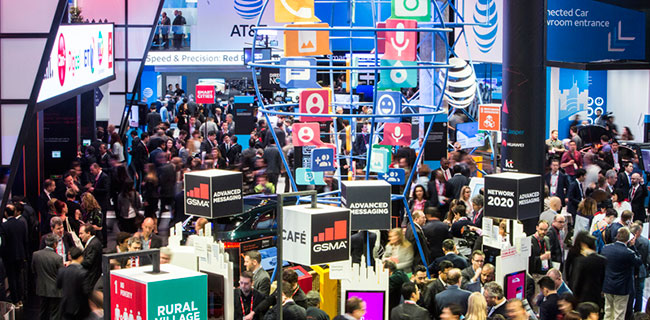Mobile World Congress (now more commonly referred to as MWC) is an annual conference that takes place each year in the bustling city of Barcelona. MWC is the world’s largest gathering for the mobile, telecom and IoT industries, with over 107,000 attendees flocking to the Fira each day with anticipation of what creations manufactures will probation. The conference also provides a unique opportunity to meet with similar organisations to network under one (very large) roof.
24,000 leading companies attended this year’s conference hoping to showcase their innovations and product announcements. Over the course of the week we witnessed futuristic concept cars, robots offering free hugs and Artificial intelligence.
This year there was particular focus on 5G, folding devices and augmented reality.
5G was the dominating theme at this year’s MWC. In recent years there has been hype building around how 5G is going to change mobile communications. It has been predicted that 5G will account for 15% of global mobile connections by 2025 and will contribute $2.2 trillion to the global economy over the next 15 years*. The arrival of 5G echo’s the worlds movement towards intelligent connectivity, with many operators racing to join this new ecosystem.
While much of the discussions around 5G have been academic up until this point, MWC was the launchpad for tangible 5G handsets to be revealed. Brands including Galaxy, LG and Huawei all gave us something to talk about with the reveal of their physical 5G hardware.
The anticipation surrounding 5G was evident with extensive advertising throughout the venue. It was also branded on every headset and the hot topic of multiple keynote speakers, which would suggest that 5G has morphed from an aspirational feature to a key management network tool for operators. MWC19 made clear that 5G gives rise to new concepts for connected devices and development of this ecosystem shows no signs of slowing down.
Another vertical of intelligent connectivity on display at this year’s MWC were foldable devices. Samsung released the Galaxy fold, which is the first phone with a foldable screen to be launched by a big manufacturer. Chinese smartphone giant Huawei unveiled the Huawei Mate X. The Mate X boasts a futuristic aesthetic with a foldable screen wrapped around the outside of the device, this model also has 5G capabilities with a retail price of over $2,000 dollars.
In the world of virtual reality, Microsoft announced its second-generation HoloLens augmented reality headset. This HoloLens headset has new immersive features by comparison to the first HoloLens released back in 2015. Microsoft promises to deliver value enhanced by reliability, security and scalability of cloud and AI services through the new device.
The week before MWC, Microsoft also announced its Microsoft Connected Vehicle Platform. MCVP is a set of services built on Microsoft Azure designed to empower the automotive industry to create customer connected driving experiences. Cubic Telecom partnered with Microsoft to be the first seamless connectivity provider as a core service offering to MCVP for a global market. This collaboration enables delivery of global scalability with local connectivity to automotive manufactures.
Overall, many key players demonstrated cutting-edge IoT applications and a migration towards this new era of connectivity. As a leader in global connectivity Cubic Telecom joins the movement to globally connect any object through an integrated end-to-end solution. We come away from Mobile World Congress 2019 with important insights and new connections to help us to drive our programmes.
*source taken from Mobile World Daily Newspaper

